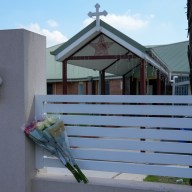Monaco has always been known as the ‘jewel in the crown’ of Formula One auto racing, but following an official announcement Tuesday, there will be a new ‘halo’ race on the New Jersey Palisades beside the Hudson River. From 2013, superstars Lewis Hamilton, Sebastian Vettel and Michael Schumacher will race on a temporary street track in the shadow of New York’s skyscrapers.
Directly over the water from Manhattan’s midtown sits sleepy Weehawken, across which the track will stretch. As Richard F. Turner, the mayor of Weehawken, put it as we gazed across the water, “We have a nice backyard.”
The street circuit, which uses already existing public roads due for relaying (F1’s Ferraris and Red Bull cars require it billiard table smooth), will be set on the side of a steep hill rather like Spa-Francorchamps – grand prix racing’s most challenging track. The 3.2-mile course features 15 largely slow-speed turns, but the straights promise top speeds of 200 mph.
“This is the second miracle on the Hudson,” added mayor of West New York, Felix Roque, referring to the emergency landing of US Airways Flight 1549 on the river in Jan. 2009. Formula One’s commercial rights holder Bernie Ecclestone first dreamed of a grand prix in or near New York City decades ago, and after a few false starts he has now inked a deal led by 63-year-old media tycoon and gentleman racer Leo Hindery.
New Jersey will become the second U.S. race on the F1 calendar, with Austin, Tex. joining the ranks next year. Jersey will be twinned with the Canadian Grand Prix in June 2013. The history of F1 in the America has been, for the most part, underwhelming. In previous decades there were two U.S. races – one on the east coast and one on the west. The sport has been searching for a new home since 2007, the last time it raced at Indianapolis. Like buses, two come along at once. New Jersey’s 10-year deal offers important stability.
The sun-drenched announcement ceremony took place at Weehawken’s Port Imperial where work on the foundations of the pit complex is already underway.
New Jersey Gov. Chris Christie boasted of the economic benefits to his state, and was keen to stress that no public money is being spent on the race. One concern of local residents is congestion, which Christie dismissed: “If, by congestion, you mean will the place be teeming with life and culture, then yes.” Another subject of concern is safety, in light of IndyCar’s fatal accident less than two weeks ago in Las Vegas. But Formula One is acknowledged as the safest motor sport in the world, and hasn’t suffered a driver fatality since Ayrton Senna in 1994.
Hindery claims this will be the “greenest race ever, due to everyone using public transport.” Manhattan’s Pier 79 is just an eight-minute ferry ride from the pitlane.
New Jersey’s officials are hoping that the glamour of F1 is going to rub off on their state — its blue collar image at odds with F1’s luxury leanings — and that an influx of over 100,000 spectators will boost the region’s accounts.
However, I put it to Hindery that the main benefactor is New York City, for the majority of team personnel and race goers will stay across the water. “I think you underestimate how great it is over here,” he told me.
Nevertheless, the TV cameras will be trained on Manhattan, and F1 personnel are excitedly plotting their shopping trips already. It’s going to be difficult for New Jersey to compete for attention, and though the race is being held on their land it will be a New York Grand Prix in all but name. And that’s exactly what Bernie Ecclestone wants.
















